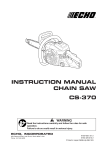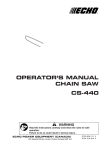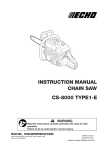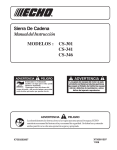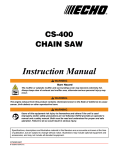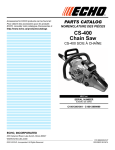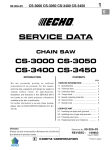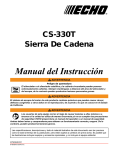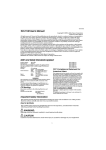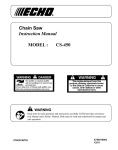Download Sharp R-370ES Operator`s manual
Transcript
OPERATOR’S MANUAL CHAIN SAW CS-370 WARNING Read the instructions carefully and follow the rules for safe operation. Failure to do so could result in serious injury. ECHO POWER EQUIPMENT (CANADA) 501 Newbold Street, London, Ontario Canada N6E 1K4 X750-008 75 1 X750 325-020 1 Printed in Japan 0608B 0861 ES RULES FOR SAFE OPERATION 1. Fatigue causes carelessness. Be more cautious before rest periods and before the end of your shift. 11. Do not attempt a pruning or liming operation in a standing tree unless specifically trained to do so. 2. Personal protective clothing required by your safety organizations, government regulations, or your employer should be used; otherwise, sung fitting clothing, protective eyewear, safety footwear and hand, leg and hearing protection should be worn. Note: Personal protective clothing should meet the requirements of applicable Standards. 3. Before fueling, servicing or transporting your chain saw switch off the engine. To help prevent fire, restart your chain saw at least 3 m from the fueling area. 12. Guard against kickback. Kickback is the upward motion of the guide bar, which occurs when the saw chain, at the nose of the guide bar, contact an object. Kickback can lead to dangerous loss of the chain saw. TO AVOID KICKBACK: (a) Contact of the guide bar tip with any object should be avoided. (b) Tip contact may cause the guide bar to move suddenly upward and backward which may cause serious injury. (c) Always use two hands when operating the chain saw. (d) Use a firm grip, thumbs and fingers encircling the handles. (e) Don’t overreach. (f) Avoid cutting above shoulder height. (g) Follow the manufacture’s instructions for sharpening and maintenance of the saw chain. 4. When using a chain saw a fire extinguisher should be available. 5. When felling, keep at least 2 tree lengths between yourself and your fellow workers. 6. Plan your work; assure yourself of an obstacle-free work area and, in the case of felling, of an escape path from the falling tree. 13. When boring with the chain saw, the initial cut should be introduced with the lower part of the nose (tip) until the hole is sufficiently large so as to introduce the entire nose (tip) of the guide bar. This technique should reduce the danger of kickback. 7. Follow instructions in your operator’s manual for starting the chain saw and control the chain saw with a firm grip on both handles when it is in operation. Keep handles dry, clean and free of oil. A chain saw should never be carried with the engine running. 14. A chain saw is intended for two-handed use. Serious injury to the operator, helpers and/or bystanders may result from one-handed operation. 8. When transporting your chain saw, use the appropriate transportation covers that should be available for the guide bar and saw chain. CAUTION A. Allow your chain saw to cool before refueling, and do not smoke while refueling. 9. Never operate a chain saw that is damaged, improperly adjusted, or is not completely and securely assembled. Be sure that the saw chain stops moving when the throttle control trigger is released. Never adjust the guide bar or saw chain when the engine operating. B. Do not allow other persons or animals close to running chain saw or close to where a tree is being felled. C. Use extreme caution when cutting small size brush and saplings because slender material may catch the saw chain and be whipped toward you. 10. Beware of carbon monoxide poisoning. Operate the chain saw in well-ventilated areas only. Copyright © 2005 CS-370 D. When cutting a limb that is under tension is alert for spring-back. All Rights Reserved. 2 CONTENTS RULES FOR SAFE OPERATION ............................................................................. SYMBOLS AND SIGNS ........................................................................................... PACKING LIST ......................................................................................................... NOMENCLATURE OF PARTS ................................................................................. OPERATOR SAFETY ............................................................................................... CORRECT USE OF CHAIN BRAKE ........................................................................ PREPARATION FOR USE ....................................................................................... FUEL AND LUBRICANT .......................................................................................... OPERATION ............................................................................................................ CUTTING INSTRUCTION ........................................................................................ CHAIN AND GUIDE BAR COMBINATION .............................................................. MAINTENANCE AND CARE .................................................................................... SETTING THE SAW CHAIN..................................................................................... TROUBLESHOOTING ............................................................................................. STORAGE AFTER USE........................................................................................... TECHNICAL DATA ................................................................................................... 1 3 5 6 8 9 10 12 13 16 21 22 26 28 29 29 This spark ignition system complies with Canadian ICES-002. This chain saw is designed for cutting wood or wood products. Do not cut solid metal, sheet metal, plastic or any non-wood materials. Specifications, descriptions and illustrative material in this literature are as accurate as known at the time of publication, but are subject to change without notice. Illustrations may include optional equipment and accessories, and may not include all standard equipment. SYMBOLS AND SIGNS CIRCLE AND SLASH SYMBOL DANGER This symbol means the specific action shown is prohibited. Ignoring these prohibitions can result in serious or fatal injury. The safety alert symbol accompanied by the word “DANGER” calls attention to an act or condition which WILL lead to serious personal injury or death if not avoided. NOTE WARNING This enclosed message provides tips for use, care and maintenance of the unit. The safety alert symbol accompanied by the word “WARNING” calls attention to an act or condition which CAN lead to serious personal injury or death if not avoided. IMPORTANT The enclosed message provides information necessary for the protection of the unit. CAUTION The safety alert symbol accompanied by the word “CAUTION” calls attention to an act or condition which may lead to minor or moderate personal injury if not avoided. 3 CS-370 SYMBOL FORM Symbol form/shape Symbol description/application Symbol form/shape Symbol description/application Carefully read the operator’s manual Chain oil fill Wear eyes, ears and head protection Chain oil pump Chain brake operation Chain oiler adjustment Emergency stop Carburetor adjustment - Low speed mixture Choke control “Cold Start” position (choke closed) Carburetor adjustment - High speed mixture Oil and gasoline mixture Carburetor adjustment - Idle speed STOP DECALS Part Number X503-007160 Part Number 890176-39431 CS-370 CAUTION/ATTENTION Hearing protectors meeting the requirements of CSA Standard Z94.2 should be worn. CAUTION: For safe operation follow all safety precautions and instructions in operator’s Manual. (Replacement manuals are available from your ECHO dealer.) Hold chain saw firmly with both hands. Les protecteurs auditifs pouvant être porter doivent recontrer les normes CSA Standard Z94.2. Part Number 890324-39630 Part Number X524-001720 REPLACEMENT BAR AND CHAIN PEMPLACEMENT DU GUIDE ET DE LA CHAÎNE ATTENTION Pour un travail en sécurité, respectez toutes les règles de sécurité et les indications du manuel d’utilisation. (Le manuel d’utilisation est disponibile chez votre agent ECHO.) Tenez fermement la tronçonneuse des deux mains. GUIDE BAR P/NO. CHAIN TYPE CKA GUIDE PIÈCE NO. TYPE DE CHAÎNE 14” 14A0CD3752 OREGON 91P/91VG 52 22.3 16” 16A0CD3757 OREGON 91P/91VG 57 20.1 18” 18A0CD3762 OREGON 91P/91VG 62 22.5 CKA means Computed Kickback Angle. CKA Signifie angle de rebondissement calculé. Note; There may be other replacement components for achieving kickback p r o t e c t i o n . Fo r d e t a i l s , p l e a s e r e fe r to the chain and bar combination sheet shown in the operator’s manual. REMARQUE; Il y peut y avoir d’autres composantes de remplacement qui protègent en cas de rebondissement. Pour plus de détails, se référer à la feuille sur les combinaisons de guide et de chaîne du manuel de l’utilisateur. Part Number X505-000450 TO AVOID KICKBACK 1. Contact of the guide bar tip with any object should be avoided. 2. Tip contact may cause the guide bar to move suddenly upward and backward which may cause serious injury. 3. Always use two hands when operating the chain saw. Part Number X505-000460 Locate this safety decal on your unit. The complete unit illustration found in the “NOMENCLATURE OF PARTS” section will help you locate them. Make sure the decal is legible and that you understand and follow the instructions on it. If a decal cannot be read, a new one can be ordered from your ECHO dealer. POUR ÉVITER LES REBONDISSEMENTS 1. Éviter tout contact entre le nez du guide-chaîne et un objet quelconque. 2. Tout contact du nez peut provoquer un mouvement brusque vers le haut ou vers le bas et entraîner de graves blessures. 3. Toujours employer lex deux mains pour opérer la scie à chaîne. CS-370 4 PACKING LIST The ECHO product you purchased has been factory pre-assembled for your convenience. Due to packaging restrictions, guide bar and saw chain installation and other assembly may be necessary. After opening the carton, check for damage. Immediately notify your retailer or ECHO dealer of damaged or missing parts. Use the packing list to check for missing parts. 13 x 19 mm T-wrench, 4 mm Hexagonal Wrench, Small screwdriver ECHO CHAIN SAW Instruction manual Safety manual Limited warranty statement Warranty registration card ECHO Power Blend™ 2-stroke oil sample Guide bar Kick Guard® Saw chain 5 CS-370 NOMENCLATURE OF PARTS 4 3 5 890324-39630 6 7 15 8 1 9 10 11 12 13 14 X524-001460 X524-001720 X505-000450 2 890176-39431 X503-007160 25 Part Number 890324-39630 ATTENTION Pour un travail en sécurité, respectez toutes les règles de sécurité et les indications du manuel d’utilisation. (Le manuel d’utilisation est disponibile chez votre agent ECHO.) Tenez fermement la tronçonneuse des deux mains. 24 16 23 17 18 Part Number X505-000460 19 20 POUR ÉVITER LES REBONDISSEMENTS 1. Éviter tout contact entre le nez du guide-chaîne et un objet quelconque. 2. Tout contact du nez peut provoquer un mouvement brusque vers le haut ou vers le bas et entraîner de graves blessures. 3. Toujours employer lex deux mains pour opérer la scie à chaîne. Part Number X524-001720 REPLACEMENT BAR AND CHAIN PEMPLACEMENT DU GUIDE ET DE LA CHAÎNE GUIDE BAR P/NO. CHAIN TYPE CKA GUIDE PIÈCE NO. TYPE DE CHAÎNE 14” 14A0CD3752 OREGON 91P/91VG 52 22.3 16” 16A0CD3757 OREGON 91P/91VG 57 20.1 18” 18A0CD3762 OREGON 91P/91VG 62 22.5 CKA means Computed Kickback Angle. CKA Signifie angle de rebondissement calculé. Note; There may be other replacement components for achieving kickback p r o t e c t i o n . Fo r d e t a i l s , p l e a s e r e fe r to the chain and bar combination sheet shown in the operator’s manual. REMARQUE; Il y peut y avoir d’autres composantes de remplacement qui protègent en cas de rebondissement. Pour plus de détails, se référer à la feuille sur les combinaisons de guide et de chaîne du manuel de l’utilisateur. CS-370 Part Number X505-000450 TO AVOID KICKBACK 1. Contact of the guide bar tip with any object should be avoided. 2. Tip contact may cause the guide bar to move suddenly upward and backward which may cause serious injury. 3. Always use two hands when operating the chain saw. 21 22 Part Number X503-007160 CS-370 CAUTION: For safe operation follow all safety precautions and instructions in operator’s Manual. (Replacement manuals are available from your ECHO dealer.) Hold chain saw firmly with both hands. Part Number 890176-39431 CAUTION/ATTENTION Hearing protectors meeting the requirements of CSA Standard Z94.2 should be worn. Les protecteurs auditifs pouvant être porter doivent recontrer les normes CSA Standard Z94.2. * If a decal cannot be read, a new one can be ordered from your ECHO dealer. 6 NOMENCLATURE OF PARTS 1. Operator’s manual - Included with unit. Read before operation and keep for future reference to learn proper, safe operating techniques. 14. Saw chain - Chain, serving as a cutting tool. 15. Bar tip guard - Anti-kickback device attached on the bar nose. 16. Cylinder cover - The cooling airflow grill. It covers the cylinder, spark plug and silencer. 2. Safety manual - Describe operating and safety instructions for this chain saw. 17. Front handle (for the left hand) - Support handle located at the front of the engine housing. 3. Front hand guard - Guard between the front handle and the saw chain for protecting the hand from injuries and aiding in control of the chain saw if the hand slips off the handle. This guard is used to lock the chain brake which is to stop the saw chain rotation. 18. Oil tank cap - For closing the oil tank. 19. Starter handle - Pull handle slowly until starter engages then quickly and firmly. When engine starts, return handle slowly. DO NOT let handle snap back or damage to unit will occur. 4. Cleaner cover knob - Device for installing the air cleaner cover. 5. Air cleaner cover - Covers air filter. 20. Fuel tank cap - For closing the fuel tank. 6. Purge pump - When starting engine, push purge pump 3 or 4 times. 21. Throttle latch - Device for temporality setting the throttle in a partially open position to aid starting. 7. Choke control knob - Device for enriching the fuel/air mixture in the carburetor to aid cold starting. 22. Throttle trigger - Device activated by the operator’s finger, for controlling the engine speed. 8. Rear hand guard - Extension on the lower part of the rear handle for protecting the hand from the chain if it breaks or degrooves. 23. Rear handle (for the right hand) - Support handle located towards the rear of the engine housing. 9. Clutch cover - Protective cover to the guide bar, saw chain, clutch and sprocket when the chain saw is in use. 24. Throttle trigger lockout - A safety lever which must be depressed before the throttle trigger can be activated in order to prevent the accidental operation of the throttle trigger. 10. Chain tension adjuster - Device to adjust chain tension. 25. Ignition switch - Device for connecting and disconnecting the ignition system and thus allowing the engine to be started or stopped. 11. Chain catcher - A projection designed to reduce the risk of the operator’s right hand from being hit by a chain which has broken or derailed from the guide bar during cutting. 12. Spiked bumper - Device, fitted in front of the guide bar mounting point, acting as a pivot when in contact with a tree or log. 13. Guide bar - The part that supports and guides the saw chain. 7 CS-370 OPERATOR SAFETY VIBRATION AND COLD EYE AND HEARING PROTECTION • It is believed that a condition called Raynaud’s Phenomenon, which affects the fingers of certain individuals, may be brought about by exposure to vibration and cold. Exposure to vibration and cold may cause tingling and burning followed by loss of color and numbness in the fingers. The following precautions are strongly recommended because the minimum exposure which might trigger the ailment is unknown. • Keep your body warm, especially the head and neck, feet and ankles and hands and wrists. • Maintain good blood circulation by performing vigorous arm exercises during frequent work breaks and also by not smoking. • Limit the number of hours of operation. Try to fill each day with jobs where operating the chain saw, or other hand-held power equipment is not required. • If you experience discomfort redness and swelling of the fingers, followed by whitening and loss of feeling, consult your physician before further exposing yourself to cold and vibration. • Wear eye protection goggles that meet ANSI Z 87.1 requirements. Goggles meeting the requirements have the mark “Z 87” stamped on them. • Wear hearing protection. If this guideline is not followed, hearing loss can occur. ECHO recommends wearing hearing protection at all times. WEAR PROPER CLOTHING • Snug fitting durable clothing should be worn. Pants should have long legs, DO NOT WEAR SHORTS. Do not wear loose fitting clothing, scarves, neckties, jewelry or any item that may become tangled in surrounding growth or the chain saw itself. • Wear shoes with non-skid soles. DO NOT wear open toed shoes or operate unit barefooted. • Wear no-slip, heavy duty work gloves to improve your grip on the chain saw handles. The gloves also help reduce the transmission of machine vibration to your hands. REPETITIVE STRESS INJURY • It is believed that over-using the muscles and tendons of the finger, hands, arms and shoulders may cause soreness, swelling, numbness, weakness and extreme pain to the areas just mentioned. Certain repetitive hand activities may put you at a high risk for developing a repetitive stress injury (RSI). • An extreme RSI condition is Carpal Tunnel Syndrome (CTS) which could occur when your wrist swells and squeezes a vital nerve that runs through the area. Some believe that prolonged exposure to vibration may contribute to CTS. CTS can cause severe pain for months or even years. To reduce the risk of RSI/CTS, do the following: • Avoid using your wrist in a bent, extended or twisted position. • Take periodic breaks to minimize repetition and rest your hands. • Reduce the speed and force in which you do the repetitive movement. • Do exercises to strengthen hand and arm muscles. • See a doctor if you feel tingling, numbness or pain in your fingers, hands, wrists or arms. The sooner RSI/CTS is diagnosed, the more likely permanent nerve and muscle damage can be prevented. CS-370 HOT HUMID WEATHER • Heavy protective clothing can increase operator fatigue which may lead to heat stroke. Schedule heavy work for early morning, or late afternoon hours when temperatures are cooler. AVOID HOT SURFACES • During operation, the muffler or catalytic muffler and surrounding cover become hot. • Never suspend the saw on a lanyard with the engine running. • Always use the saw from the right-hand side of your body - NEVER from the left side. • Always wear proper safety clothing to protect your lower body from sharp saw chain and hot muffler. • Always keep exhaust area clear of flammable debris during transportation or when storing, otherwise serious property damage or personal injury may result. 8 SPARK ARRESTOR MUFFLER • The spark arrestor muffler controls the exhaust noise and prevents hot, glowing particles of carbon from leaving the muffler. Make sure the spark arrestor screen is in good repair and properly seated in the muffler. • Certain internal combustion engines operated on forest, brush, and/or grass-covered areas in the states of Washington, Oregon, Idaho, California, Minnesota, New Jersey and Maine, are required to be equipped with a spark arrestor. This requirement also applies to all U.S. Forest Service lands. In some of these areas, the spark arrestor system must be certified per USDA Forest Service Regulation SAE J 335. Check with your local or state authorities for specific regulations in your area. Failure to follow these requirements is a violation of the law. CORRECT USE OF CHAIN BRAKE Rotational kickback DANGER Kickback safety precaution for chain saw users: Kickback may occur when the nose or tip of the guide bar touches an object or when the wood closes in and pinches the saw chain in the cut. The installation of a chain brake may be mandatory by law or as stipulated by insurance regulations in your area of operation. You should inquire through local government offices, your employer or your local dealer to ensure that your chain saw conforms to the required safety standard. ECHO chain brakes have been designed and tested to comply with international safety standards as follows. Reduced radius belongs on top Canada : CSA Standard Z 62.1, Standard Z 62.3 CHAIN SAWS USA Rotational kickback : ANSI Standard B175.1-2000 Safety Requirement for chain saws WARNING CSA Z 62.1 stipulates that the brake shall stop the chain 0.12 seconds at an engine speed of 13,500 r/min. It is the responsibility of the owner/operator to ensure that the brake is serviced, adjusted and tested strictly in accordance with the instructions as detailed herein in order to ensure that the brake performance is maintaind in compliance with the Standard CSA Z 62.1. Chain moving downward at impact Liner kickback Pinch Kickb ack 9 CS-370 PREPARATION FOR USE WARNING Saw chain is sharp! Always wear gloves when handling assembly, otherwise serious personal injury may result. KICK GUARD® TO BAR INSTRUCTIONS Tools Needed: Two 11 mm Wrenches. For saws with Kick Guard® P/N 2893201 and Symmetrical Low-Kick type (Double Guard) guide bars. Bolt (A) Dimple (D) 1. Install bolt (A) in rear hole (B) of Kick Guard® and through front hole (C) in guide bar. ® Kick Guard Rear hole (B) 2. IMPORTANT: Dimple (D) in Kick Guard® must engage recess (E) in guide bar. Recess (E) Front hole (C) 3. Tighten nut (F) and bolt (A) using 11 mm wrenches until snug. Make certain Kick Guard® is flush against guide bar. 4. Tighten nut (F) 1/8 additional turn. Nut (F) Guide bar 5. Check to make certain Kick Guard® is tight on guide bar. GUIDE BAR AND SAW CHAIN INSTALLATION/REMOVAL NOTE Brake lever (Front hand guard) Move the chain brake lever (Front hand guard) fully rearward to remove or install the clutch cover to chain saw. Brake connector 1. Remove spark plug lead. (See page 24) 2. Remove two clutch cover nuts and remove clutch cover. 3. Remove bar and saw chain if necessary. See “Maintenance and Care” section for guide bar/ saw chain maintenance procedures. Clutch cover Two nuts CS-370 10 4. Mount guide bar on studs and slide toward clutch to make saw chain installation easier. Install chain with cutters on top of guide bar facing forward. 5. Unlock the chain brake, and install the clutch cover over the guide bar studs. Ensure chain tension adjuster pin fits into the guide bar adjuster hole, brake band is positioned around clutch drum. Tighten clutch cover nuts finger tight. 6. Turn saw over, and check brake band for correct position on clutch drum. If brake band is not in place around drum, remove cover, make sure brake is unlocked, and reinstall. Tighten clutch cover nuts finger tight. Guide bar studs Clutch Guide bar adjuster hole Nuts Adjuster pin Clutch cover Brake band Brake connector WARNING Improper clutch cover assembly can result in serious injury, and will cause severe saw damage if unit is started. Never start or operate saw if brake band is not in place on clutch drum. Always check chain brake operation after replacing cover. Do not use saw if chain brake does not function properly. Unlock chain brake ADJUSTING CHAIN TENSION Direction to tension the chain IMPORTANT Always loosen clutch cover nuts before turning the chain tension adjuster, otherwise the clutch cover and tensioner will be damaged. 1. Remove spark plug lead. (See page 24) Adjusting screw 2. Loosen two clutch cover nuts, if necessary. 3. Hold the bar nose up, and turn the adjuster screw clockwise until chain fits snugly against underside of the bar. 4. Tighten both nuts with the bar nose held up. 5. Pull the chain around the bar by hand. Loosen the adjustment if you feel tight spots. Proper tension Improper tension 6. When chain is properly tensioned, tighten clutch cover nuts securely - 20 to 23 N·m (200 to 230 kgf·cm). 7. Keep chain properly tensioned at all times. 11 CS-370 FUEL AND LUBRICANT Fuel Mix Chart 50 : 1 FUEL STATEMENT Gasoline L 4 8 20 GASOLINE - Use 89 Octane [(R+M)/2] (mid grade or higher) gasoline or gasohol known to be good quality. Gasohol may contain up to 10 % Ethyl (grain) alcohol or 15 % MTBE (methyl teriary-butyl ether). Gasohol containing methyl (wood) alcohol is NOT approved. TWO-STROKE OIL - A two-stroke engine oil meeting ISO-L-EGD (ISO/CD 13738) and JASO FC Standards must be used. ECHO brand premium Power Blend™ Universal 2-Stroke Oil meets these standards. Engine problems due to inadequate lubrication caused by failure to use an ISO-L-EGD and JASO FC certified oil, such as ECHO premium Power Blend™, will void the two-stroke engine warranty. (Emission related parts only are covered for two years, regardless of two-stroke oil used, per the statement listed in the Emission Defect Warranty Explanation.) Oil mL 80 160 400 IMPORTANT • ECHO premium Power Blend™ Universal 2Stroke Oil may be mixed at 50 : 1 ratio for application in all ECHO engines sold in the past regardless of ratio specified in those manuals. • Use of unmixed, improperly mixed, or fuel older than 90 days, (stale fuel), may cause hard starting, poor performance, or severe engine damage and void the product warranty. Read and follow instructions in the Storage section of this manual. HANDLING FUEL DANGER MIXING INSTRUCTIONS 1. Fill an approved fuel container with half of the required amount of gasoline. 2. Add the proper amount of two-stroke oil to gasoline. 3. Close container and shake to mix oil with gasoline. 4. Add remaining gasoline, close fuel container, and remix. Fuel is VERY flammable. Use extreme care when mixing, storing or handling or serious personal injury may result. • Use an approved fuel container. • DO NOT smoke near fuel. • DO NOT allow flames or sparks near fuel. • Fuel tanks/cans may be under pressure. Always loosen fuel caps slowly allowing pressure to equalize. • NEVER refuel a unit when the engine is HOT! • NEVER refuel a unit with the engine running. • DO NOT fill fuel tanks indoors. ALWAYS fill fuel tanks outdoors over bare ground. • Securely tighten fuel cap after refueling. • Inspect for fuel leakage. If fuel leakage is found, do not start or operate unit until leakage is repaired. • Move at least 3 m from refueling location before starting the engine. IMPORTANT • Spilled fuel is a leading cause of hydrocarbon emissions. Some states may require the use of automatic fuel shut-off containers to reduce fuel spillage. • Stored fuel ages. Do not mix more fuel than you expect to use in thirty (30) days, ninety (90) days when a fuel stabilizer is added. • Stored two-stroke fuel may separate. ALWAYS shake fuel container thoroughly before each use. AFTER USE DO NOT store a unit with fuel in its tank. Leaks can occur. Return unused fuel to an approved fuel storage container. STORAGE Fuel storage laws vary by locality. Contact your local government for the laws affecting your area. As a precaution, store fuel in an approved, airtight container. Store in a well-ventilated, unoccupied building, away from sparks and flames. CS-370 12 CHAIN LUBRICANT CAP INDICATION Fuel/oil tanks are indicated by the following illustrations. FUEL TANK CAP Proper lubrication of the chain while in operation reduces friction between the chain and the guide bar to a minimum and assures a longer service life. • Use bar and chain oil of high quality for this purpose. • Do not use used or reclaimed oil to avoid various oiler problems. • Use ECHO bar and chain oil. • When ECHO bar and chain oil is not available: Use motor oil, etc. • Use bar and chain oil of the following grades: SAE No. 30 ....... in summer SAE No. 10 ....... in winter or when cutting resinous trees. • When refueling, also refill chain oil. OIL TANK CAP OPERATION WHEN THE ENGINE IS COLD Chain brake CAUTION Make sure bar and chain are free from any obstruction when starting the saw. • Move chain brake lever fully forward to lock chain brake before starting. • Fill the fuel tank with fuel mixture. It is not permitted to fill fuel above the shoulder level of fuel tank. • Fill the chain oil tank with lubricant. Do not over fill. • Move ignition switch to “RUN” position. • Push purge pump 3 to 4 times or until fuel is visible in purge pump. Ignition switch START/RUN Purge pump • Pull choke control knob all the way out. (Choke position) Choke control knob CHOKE • Securely hold the chain saw as shown and pull starter handle several times until first firing sound. • Push choke control knob all the way in. • Pull starter handle to start the engine. Starter handle • After starting the engine, pull front hand guard towards the operator immediately. (Chain brake unlocked position) Unlock chain brake 13 CS-370 WHEN THE ENGINE IS HARD TO START Chain brake CAUTION Make sure bar and chain are free from any obstruction when starting the saw. • Move chain brake lever fully forward to lock chain brake before starting. • Press throttle trigger lockout down while grasping throttle trigger and push in throttle latch. • Move ignition switch to “RUN” position. • Securely hold the chain saw as shown and pull starter handle. • When engine starts, immediately squeeze throttle trigger, to release throttle latch, and pull front hand guard towards the operator immediately. (Chain brake unlocked position) Ignition switch Throttle trigger lockout START/RUN PUSH Throttle latch Throttle trigger CAUTION 1. When using throttle latch for starting, keep the brake in lock position. 2. After starting the engine, squeeze throttle trigger slightly to release throttle latch and pull front hand guard towards the operator immediately. (Chain brake unlocked position) 3. Do not increase engine speed while chain brake is engaged. 4. Use the chain brake only in starting or in emergencies. Starter handle Unlock chain brake CAUTION The chain will attempt to rotate when engine is started with throttle latch engaged. After engine starts, release throttle trigger to idle engine, otherwise brake damage may occur. Never use throttle latch for cutting. Use it only when starting the engine. WHEN THE ENGINE IS WARM • Move chain brake lever fully forward to lock chain brake before starting. • Confirm there is fuel and chain oil in the tanks. • Move ignition switch to “RUN” position. • Securely hold the chain saw as shown and pull starter handle. • Choke may be used if necessary, but be sure to push it back on first firing sound. • After starting the engine, pull front hand guard towards the operator immediately. (Chain brake unlocked position) Choke control knob OPEN CHOKE Unlock chain brake CS-370 14 RUNNING • When engine starts, keep idling for a few minutes. • Set the brake lever in the unlocked position before starting to cut. • Pull throttle trigger gradually and increase revolution of the engine. • The chain starts running when the engine reaches to 3,800 r/min approximately. • Confirm proper acceleration and lubrication of chain and bar. • Do not run the engine at high speed unnecessarily. • Be sure that saw chain stops moving when throttle trigger is released. STOPPING • Release throttle trigger and move ignition switch down to “STOP” position. Ignition switch STOP NOTE If engine does not stop, pull choke control knob out fully to stop engine. Return the unit to your authorized ECHO dealer to check and repair stop switch before starting the engine again. Throttle trigger CHECKING CHAIN TENSION • Chain tension should be checked frequently during work and corrected as necessary. • Tension the chain as tight as possible, but so it can still be pulled easily along the bar by hand. CAUTION Do not operate with a loose chain. CHAIN LUBRICATION TEST Hold the chain just above a dry surface and open the throttle to half speed for 30 seconds. A thin line of “thrown” oil should be seen on the dry surface. 15 CS-370 CUTTING INSTRUCTION GENERAL CAUTION • Read the ECHO “CHAIN SAW SAFETY MANUAL” included with your chain saw for additional cutting and safety instructions. • Wear suitable hearing protection such as earmuffs or earplugs to protect against objectionable or uncomfortable loud noises. • Do not let the tip of the bar touch anything while the engine is running. At cutting speed the chain is moving at a high rate of speed. Should the tip contact a limb or log while the chain is moving, the tip will be pushed upward with considerable force. This is known as kickback. Avoid it! In all circumstances the operation of the chain saw is a one-man job. It is difficult at times to take care for your own safety, so don’t assume the responsibility for a helper as well. After you have learned the basic techniques of using the saw, your best aid will be your own good common sense. The accepted way to hold the saw is to stand to the left of the saw with your left hand on the front handlebar and your right hand on the rear handle so you can operate the throttle trigger with your right index finger. Before attempting to fell a tree, cut some small logs or limbs. Become thoroughly familiar with the controls and the responses of the saw. Start the engine, see that it is running properly. Squeeze the trigger to open the throttle wide open and start the cut. If the chain is properly sharpened, the cutting should be relatively effortless. It is not necessary to press down hard to make the saw cut. Pushing the saw too hard will slow the engine and cutting will actually be more difficult. Some material may adversely affect the housings of your chain saw. (Example palm Tree Acid, fertilizer etc.) To avoid housing deterioration, carefully remove all packed sawdust around clutch and guide bar area and wash with water. Coat metal parts with light oil. Kickback CS-370 16 FELLING THE TREE A falling tree can seriously damage anything it may hit - a car, a house, a fence, a power-line, or another tree. There are ways to make a tree fall where you want it, so first decide where that is! Before cutting, clear the area around the tree. You will need good footing while working and you should be able to work the saw without hitting any obstacles. Next, select a path of retreat. When the tree begins to fall you should retreat away from the direction of fall at a 45-degree angle and at least 3 m from the trunk to avoid the trunk kicking back over the stump. 3m Retreat Direction of fall 45° 45° Retreat Not this way Begin the cut on the side to which the tree is to fall. Cut a notch about 1/3 of the way into the tree. The position of this notch is important since the tree will try to fall “into” the notch. The felling cut is made on the side opposite the notch and at a level about 5 cm above the bottom of the notch. Do not try to cut through to the notch with the felling cut. The remaining wood between the notch cut and felling cut about 5 cm will act as a hinge when the tree falls, guiding it in the desired direction. When the tree starts to fall, kill the engine, place the saw on the ground and make your retreat quickly. Direction of fall Hinge First cut 5 cm Felling cut Notch Second cut 5 cm One-third tree diameter To fell big trees with a diameter exceeding twice the bar length, start the notching cuts from one side and draw the saw through to the other side of the notch. Start the back cut on one side of the tree, pivoting the saw through to form the desired hinge on that side. Then remove the saw for the second cut. Insert the saw in the first cut, very carefully so as not to cause kickback. The final cut is made by drawing the saw forward in the cut to reach the hinge. 3 1 2 17 CS-370 LIMBING Limbing a fallen tree is much the same as bucking. Never stand on the tree that you are limbing. When limbing, caution is the word. Be careful of the tip touching other limbs. Always use both hands. Don’t cut with the saw overhead or aligned vertically with your body. If the saw should kickback, you may not have enough control to prevent possible injury. BUCKING Bucking is the sawing of a log or fallen tree into smaller pieces. There are a few basic rules which apply to all bucking operations. Keep both hands on the handles at all times. Support logs if possible. When cutting on a slope or hillside, always stand uphill. Keep in mind that the wood is heavy and that it will bend and pinch the saw if improperly supported. The trunk will weaken at the point where you make the cut unless the tree is lying on perfectly flat ground or supported as shown. If you make the cut with the tree on the ground, don’t let the saw’s chain dig into the earth; it is harmful for the saw, and you stand a good chance of being struck by flying debris. To cut the trunk, use the bucking and two-cut sequence shown. The first cut should be no deeper than one-third the trunk diameter. Uphill position Finish cut DANGER • Kickback is generated when the rotation of the chain is arrested for some reason. The most dangerous effect of this action occurs when the nose of the bar contacts another object, the chain is momentarily stopped and all the energy of the engine throws the bar upwards and backwards towards the operator. • The chain saw industry and government agencies have attempted to prescribe various safety devices, but the best protection is to avoid kickback. • Comply with the safety precautions as listed in this Manual and Safety Manual. First cut CS-370 18 CHAIN BRAKE OPERATION Kickback motion • Set the lever in the unlocked position before starting to cut. • If the brake is tripped by kickback reaction, the chain will stop immediately. Release the throttle to avoid possible damage to the engine or clutch. • Do not attempt to operate the engine with the brake locked. TESTING THE BRAKE • Start the engine on a solid level surface and run at a fast idle until warm. • Hold the saw firmly by the handles and accelerate the engine to a fast idle. Kickback • Slowly operate the chain brake lever while holding the saw firmly on the ground. When the brake lever trips, the chain should stop. Immediately release the throttle trigger. WARNING If the chain does not stop immediately, return the saw to your authorized ECHO dealer for repair. Chain brake function When the lever is pushed forward, chain brake instantly stops the chain. NOTE • For practice, while cutting a small tree, push the lever forward to lock the brake. • Confirm that the brake works properly before each use. • If the chain brake is clogged with wood chips, function of the brake may deteriorate. Always keep the device clean. • Do not increase engine revolution while the chain brake is locked. • Use the chain brake only in starting or in emergencies. • When using throttle latch at starting, keep the chain brake locked. And after starting the engine, unlock the brake immediately. Chain brake unlock When the lever is fully pulled, toward the operator, brake is unlocked. IMPORTANT Do not allow the saw to tip forward in order to avoid damage to the chain. 19 CS-370 AUTOMATIC CHAIN BRAKE END OF THE GUIDE BAR may be placed at the height of about 35 cm. Kickback produced from the tip of the guide bar will trip the automatic chain brake. To make sure that the automatic chain brake operates properly, follow these steps: 1. Stop the engine. 2. Hold the saw with the guide bar approximately 35 cm above a wooden surface. Right hand should hold the rear handle, and left hand should hold the front handle. 3. Release the front handle and drop the end of the guide bar against the wooden surface. 4. The impact should lock the chain brake. 35 cm IMPORTANT When checking the operation of the automatic chain brake, use a soft surface substance like wood to provide the impact so the chain is not damaged. Rear handle should be gripped lightly with the right hand. WINTER OPERATION Air cleaner cover Use the winter kit with chain saw to prevent carburetor trouble in winter. • Remove air cleaner cover. Remove plug from warm weather position, and install into cold weather “storage” position. Plug Cold weather “storage” position Warm weather position NOTE For operation at normal temperature return the plug to its original place. (5°C) It causes over heating of the engine. CS-370 20 CHAIN AND GUIDE BAR COMBINATION The following combinations are recommended to the model CS-370. Length mm (in.) Guide Bar ECHO Part No. Double Guard Pitch mm (in.) Saw chain Type (OREGON) Links 356 (14) 14A0CD3752 9.53 (3/8) 91P, 91VG 52 @ 406 (16) 16A0CD3757 9.53 (3/8) 91P, 91VG 57 457 (18) 18A0CD3762 9.53 (3/8) 91P, 91VG 62 @ Standard configuration GUIDE BAR (Low-kickback) Replacement guide bars. The following guide bars may be considered to have equivalent kickback energy. • Sprocket nose guide bars of the same length and nose radius, same pitch and having the same number of teeth. • Hard nose guide bars of the same length and nose radius as a sprocket nose bar. SAW CHAIN (Low-kickback) CAUTION Do not use replacement saw chain unless it has been designated as meeting the CSA Z 62.3 kickback performance requirements. NOTE LOW KICKBACK SAW CHAIN meets the kickback performance requirements of CSA Z 62.3 (safety requirements for gasoline-powered chain saws). 21 CS-370 MAINTENANCE AND CARE Your ECHO chain saw is designed to provide many hours of trouble free service. Regular scheduled maintenance will help your chain saw achieve that goal. If you are unsure or are not equipped with the necessary tools, you may want to take your unit to an ECHO Service Dealer for maintenance. To help you decide whether you want to DO-IT-YOURSELF or have the ECHO Dealer do it, each maintenance task has been graded. If the task is not listed ask your ECHO dealer for repairs. SKILL LEVELS Level 1 = Easy to do. Most required tools come with unit. Level 2 = Moderate difficulty. Some specialized tools may be required. Level 3 = Experience required. Specialized tools are required. ECHO recommends that the unit be returned to your ECHO dealer for servicing. ECHO offers REPOWER™ Maintenance Kits and Parts to make your maintenance job easier. Just below each task heading are listed the various part numbers required for that task. Ask your ECHO dealer for these parts. Yearly or 600 Hours 6 Months or 270 Hours 3 Months or 90 Hours Every refuel Maintenance procedure Daily or Before use Component/system Required Skill level MAINTENANCE INTERVALS Recommended ECHO Dealer Maintenance Procedures Cylinder Exhaust Port Inspect/Clean/Decarbon 3 I/C Do-It-Yourself Maintenance Procedures Air Filter Inspect/Clean/Replace 1 I/C Automatic Oiler Inspect/Adjust 1 I Oil Filter Inspect/Replace 1 I/R* Fuel Filter Inspect/Replace 1 I Guide Bar and Oil Holes Inspect/Clean 1 I/C Sprocket Inspect/Replace 2 I/R* Spark Plug Inspect/Clean/Replace 2 Cooling System Inspect/Clean 2 Muffler Spark Arrestor Inspect/Clean/Replace 2 Starter Rope Inspect/Replace 1 I/R* Screws/Nuts/Bolts Inspect/Tighten/Replace 1 I/R* Meintenance Procedure Letter Codes: I = INSPECT C = CLEAN R = REPLACE * = All recommendations to replace are based on the finding of damage or wear during inspection. CS-370 R* I/C R* R* I/C I/R* IMPORTANT Time intervals shown are maximum. Actual use and your experience will determine the frequency of required maintenance. 22 CARBURETOR ADJUSTMENT Idle adjusting screw Every unit is run at the factory and the carburetor is set in compliance with Emission Regulations. In addition, the carburetor is equipped with “H” (High Speed) and “L” (Low Speed) needle adjustment limiters that prevent settings outside acceptable limits. Low speed needle (L) 1. Before adjusting carburetor clean or replace air filter and muffler “Spark Arrestor Screen”. 2. Make sure the bar and chain are properly adjusted. 3. Start engine and run several minutes to bring to operating temperature. Flash choke twice during warm-up to clear any air from the fuel system. 4. Stop engine. Turn “H” speed needle counterclockwise (CCW) to stop. Turn “L” speed needle midway between full clockwise (CW) stop and CCW stop. 5. Idle Speed Adjustment: • Start engine, turn “Idle” speed adjustment screw CW until the saw chain begins to turn, then turn screw out CCW until the saw chain stops turning. Turn screw out, CCW, an additional 1/4 turn. High speed needle (H) WARNING Cutting attachment must not move when unit is idling. 6. Accelerate to full throttle for 2 - 3 seconds to clear any excess fuel in the engine, then return to idle. Accelerate engine to full throttle to check for smooth transition from idle to high speed. If engine hesitates turn “L” needle CCW 1/8 turn and repeat acceleration. Continue adjustment until smooth acceleration results. 7. Check idle speed and reset if necessary as described in item 5. If a tachometer is available idle speed should be set to 2,400 - 2,900 r/min. CAUTION When starting, idling adjustment speed should be adjusted not to rotate the saw chain. Correct idle speed is adjusted 2,400 to 2,900 r/min. Or 1/4 turn CCW from the point the chain stops moving. When you experience trouble with the carburetor, contact your dealer. 23 CS-370 Cleaner cover knob AIR FILTER Air cleaner cover • Check before every use. • Loosen cleaner cover knob and remove air cleaner cover and filter. • Brush off dust lightly, or clean with compressed air, or replace the air filter. • Reinstall air filter and cover. Spark plug Air filter cover Air filter CHECK FUEL SYSTEM • Check before every use. • After refueling, make sure fuel does not leak from around fuel pipe, fuel grommet or fuel tank cap. • In case of fuel leakage there is a danger of fire. Stop using the machine immediately and request your dealer to inspect or replace. Cylinder cover SPARK PLUG • Check periodically. • The standard spark gap is 0.6 to 0.7 mm. • Correct the spark gap if it is wider or narrower than the standard gap. • Fastening torque: 15 to 17 N·m (150 to 170 kgf·cm). 0.6 to 0.7 mm FUEL FILTER • Check periodically. • Do not allow dust to enter fuel tank. • A clogged filter will cause difficulty in starting engine or abnormalities in engine performance. • Pull the fuel filter out through fuel inlet port with a piece of steel wire or the like. • When the filter is dirty, replace it. • When the inside of the fuel tank is dirty, rinsing the tank out with gasoline can clean it. Oil filter Fuel filter Oil tank cap Fuel tank cap OIL FILTER • Check periodically. • Do not allow dust to enter into oil tank. • A clogged oil filter will affect the normal lubricating system. • Pull it out through oil filling hole with a piece of steel wire or the like. • If the filter is dirty, wash it in gasoline or replace it. • When the inside of the tank gets dirty, rinsing the tank out with gasoline can clean it. CS-370 24 GUIDE BAR Groove Oil hole • Clean before using. - Clean the groove of the guide bar with a small screwdriver. - Clean oil holes with a wire. • Check sprocket and the clutch and clean the bar mount area before installation of the bar. Replace either or both if worn. SPROCKET Worn : 0.5 mm • A damaged sprocket will cause premature damage or wear of saw chain. - When the sprocket has worn out 0.5 mm or more, replace it. • Check sprocket when you install new chain. Replace it if worn. CYLINDER FINS • Check periodically. • Clogged fins will result in poor engine cooling. • Remove dirt and dust from between fins to let cooling air pass easily. Cylinder fins MUFFLER SPARK ARRESTOR • Remove air cleaner cover and remove spark plug lead. • Remove spark arrestor screen cover and screen from muffler body. • Clean carbon deposits from muffler components. • Replace screen if it is cracked, or has holes burned through. • Assemble components in reverse order. Muffler Spark arrestor screen Screen cover NOTE Carbon deposits in muffler will cause drop in engine output. Spark arrestor screen must be checked periodically. AUTOMATIC OILER Adjusting screw Decrease • The discharge volume of the automatic oiler is adjusted to 4 mL/min approximately at 7,000 r/min, prior to shipment from factory. - To increase the delivery volume, turn the adjusting screw counterclockwise. When the screw touches stopper and stops, this position indicates maximum discharge volume. (13 to 14 mL/min at 7,000 r/min) - Do not turn the adjusting screw beyond the maximum or minimum limit of volume adjustment. Increase 25 CS-370 SETTING THE SAW CHAIN Preset tie strap Left hand cutter Drive link Top plate Tie strap Side plate Guard link Depth guage Right hand cutter Important points for proper maintenance of saw chain: • Keep the cutters sharp at all times. • Keep the left and the right cutters properly aligned. - Note that blunt or irregular cutters will result in poor cutting performance, increased vibration of chains and premature breakage of the saw chain. • Drive link serves to remove sawdust from the groove of the guide bar. Keep the lower edge of the drive link sharp where indicated. Sharpen lower edge SETTING SAW CHAIN • For setting saw chain, round file (4.0 mm dia. 5/32 in.) and flat file are used. • To keep correct position and correct angle, use the file holder (Sure Sharp®). 30° Keep this angle Push file as shown 90° Hold the file horizontally CS-370 26 1/5 One fifth of file diameter remains above cutter edge • Place the depth gauge tool firmly on guide bar so that depth gauge protrudes. Then file top of depth gauge with the flat file until flat with top of the depth gauge tool. Depth gauge tool Remove until flat with tool - Be sure to round off the front edge of the depth gauge. Round off the edge Properly filed cutters are shown in illustration. 91P :85° 91VG:80° When setting of the chain is finished, soak it in oil and wash away filings completely before using. - When chain has been filed on the bar, supply sufficient oil to it, rotate the chain slowly to wash away the filings before using again. - If the chain saw is operated with filings clogged in the groove, the saw chain and the guide bar will be damaged prematurely. - If the saw chain becomes soiled with resin, for instance, clean it with kerosene and soak in it oil. 30° Top plate filing angle Side plate angle 91P :50° 91VG:60° 0.64 mm (0.025 in.) NOTE These angles are referred to as Oregon 91P or 91VG. To sharpen other follow chain manufacturer’s instruction. Top plate cutting angle Depth gauge Parallel 27 CS-370 TROUBLESHOOTING Problem Engine — hard to start — does not start Engine cranks Fuel at carburetor No fuel at carburetor • Fuel filter clogged • Fuel line clogged • Carburetor • Clean or replace • Clean • Ask your ECHO dealer Fuel at cylinder No fuel at cylinder • Carburetor • Ask your ECHO dealer Muffler wet with fuel • Fuel mixture is too rich • Open choke • Clean/replace air filter • Adjust carburetor • Ask your ECHO dealer Spark at end of plug wire No spark at end of plug wire • Ignition switch off • Electrical problem • Turn switch on • Ask your ECHO dealer Spark at plug No spark at plug • Spark gap incorrect • Covered with carbon • Fouled with fuel • Spark plug defective • Adjust 0.6 mm to 0.7 mm • Clean or replace • Clean or replace • Replace plug • Internal engine problem • Ask your ECHO dealer • Air filter dirty • Fuel filter dirty • Fuel vent blocked • Spark plug • Carburetor • Cooling system blocked • Exhaust port/spark arrestor screen blocked • Clean or replace • Clean or replace • Clean • Clean and adjust/replace • Adjust • Clean • Clean Engine does not crank Engine runs Dies or accelerates poorly Cause Remedy WARNING Fuel vapors are extremely flammable and may cause fire and/or explosion. Never test for ignition spark by grounding spark plug near cylinder plug hole, otherwise serious personal injury may result. CS-370 28 STORAGE AFTER USE • Inspect and adjust every part of the chain saw. - Completely clean every part and repair if necessary. - Apply thin coating of oil on metal parts to prevent rust. • Remove chain and guide bar. • Drain fuel tank, pull starter slowly a few times to drain fuel from carburetor. • Pour a small amount of clean motor oil into spark plug hole, pull starter and crank the engine until piston reaches: TOP DEAD CENTER. • Store in a dry area, free from dust. WARNING Do not store in an enclosure where fuel fumes may accumlate or reach an open flame or spark. CAUTION Do not lend or rent your chain saw without the Operator’s manual and Safety manual. NOTE • For future reference, you should keep this Operator’s manual and the Safety manual. • If this Operator’s manual or the Safety manual has become illegible or is lost, please purchase a new one from your ECHO dealer. TECHNICAL DATA CS-370 Dimension L×W×H mm 393 × 245 × 277 Mass Power head, dry kg 4.5 Without chain and guide bar Engine Type Displacement Fuel mL (cm³) Diaphragm type Flywheel magneto: CDI system NGK BPMR8Y Recoil starter Automatic centrifugal clutch Mixture ratio 50 : 1 ratio with ECHO Power Blend™ two-stroke, air-cooled engine oil. 89 octane unleaded. Do not use fuel containing methyl alcohol, more than 10 % ethyl alcohol or 15 % MTBE. L Bar and chain Tank capacity 0.41 ECHO bar and chain oil (or motor oil) L Guide bar and saw chain 0.28 See page 21 for Chain and Guide Bar Combination Lubrication Engine speed 36.3 Carburetor Magneto Spark plug Starter Power transmission Tank capacity Oil Air-cooled two-stroke single cylinder Idle Wide open throttle Adjustable automatic oil pump r/min r/min Standard features 2,400 - 2,900 12,000 - 12,500 Front hand guard, Rear hand guard, Anti-vibration device, Spiked bumper, Throttle control lockout, Chain brake, Chain catcher, Spark arrestor muffler, Kick guard * Technical data subject to change without notice. 29 CS-370 10002001/10999999






























